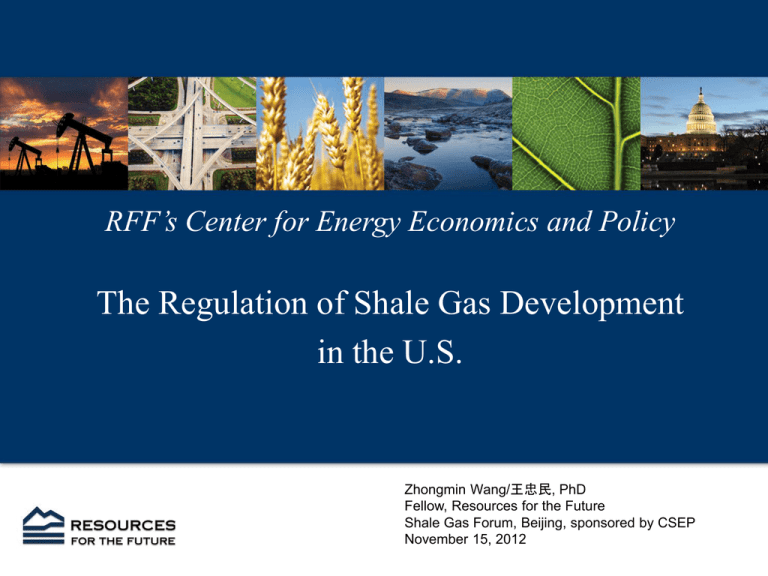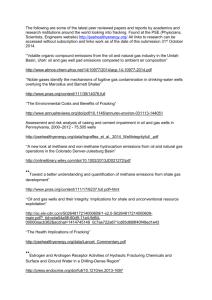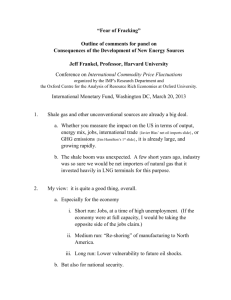The Regulation of Shale Gas Development in the U.S.
advertisement

RFF’s Center for Energy Economics and Policy The Regulation of Shale Gas Development in the U.S. Zhongmin Wang/王忠民, PhD Fellow, Resources for the Future Shale Gas Forum, Beijing, sponsored by CSEP November 15, 2012 Background (not in handout) • Different from China, little shale gas development in the U.S. takes place on public land. • Focuses on regulations of shale gas development on privately owned lands; discuss briefly how conventional oil & gas development on federal land is regulated at the end • The vast majority of relevant regulations exist before shale gas boom, though some updated regulations are specific to shale gas 2 Overview Four levels of governments regulate onshore oil and gas development • • • • Most regulations at the states (initial purpose was resource conservation and environmental protection added later) Federal regulations (environmental & safety laws since the 1970s) River Basins (only two have regulatory authority) Local Regulations cover every aspect of exploration and operation • • • Well design, location, spacing, operation, abandonment Water/waste management & disposal, air emissions, underground injection, wildlife impacts, surface disturbance Worker health and safety The legal system and the public also constrain firm behavior • • Tort law Environmental groups and the press Federal laws applicable to shale gas development • Water • Clean Water Act • Safe Drinking Water Act • Air • Clean Air Act • Land • Endangered Specifies Act • Safety • • Occupational Safety and Health Act Oil & gas industry exempted from several federal environmental laws Federal laws Implementation and Enforcement Federal laws on Water, Air, and Land • • Administered by Environmental Protection Agency (EPA) Most of these laws allow EPA to grant ‘primacy’ to the states • • • • State agencies implement the laws with federal oversight States can adopt their own regulations, which must be at least as strict as the federal laws EPA does not have the resources to administer all of these laws ‘One size fits all’ regulations may be undesirable Occupational Safety and Health Act • Administered by Occupational Safety and Health Administration Safe Drinking Water Act (SDWA) • Protects the quality of drinking water • EPA requires Underground Injection Control permits for underground injection of hazardous substance • • Applies to enhanced recovery wells and disposal wells Operators must 1. demonstrate casing and cementing are adequate 2. pass an integrity test at the beginning and once every five years 3. identify other wells within certain distance 4. comply with monitoring requirements (injection pressure, rate, and fluids volume) • Energy Policy Act of 2005 amended SDWA so that fracking itself does not require a permit unless diesel is used in the frack fluid (Halliburton loophole) • EPA can issue imminent and substantial endangerment orders • • EPA can conduct investigations and order firms to take immediate actions Firms can contest the order in court Clean Water Act (CWA) • Regulate pollutant discharge into surface waters and respond to spills affecting rivers and streams • National Pollutant Discharge Elimination System (NPDES) limits type & amount of polluants that can be discharged into surface water. • • • • Spill Prevention, Control, and Countermeasure (SPCC) rule. • • EPA establishes effluent limitation guidelines\standards for oil & gas extraction For the onshore category, zero direct discharge into surface water (alternatives feasible: underground injection,treatment facilities) Requires management plans to control storm water discharge, but the oil & gas industry is largely exempt from this requirement. Nearly all well sites near navigable water are subject to this rule Imminent and Substantial Endangerment and Release Response Orders Clean Air Act (CAA) • Regulates air emissions • On 04/17/12, EPA issued new rules to reduce harmful air emissions from the oil and gas industry, to be fully implemented by 2015 • First federal air standards for fracked natural gas wells • A response to lawsuits by environmental groups • EPA failed to update its standards on volatile organic compound (VOC), SO2, and air toxics for oil & gas industry in a timely manner • Requires ‘green completion’ to capture air emissions • Special equipment separates gas and liquid hydrocarbons from flowback • Green completion reduces VOCs, air toxics, and methane • Requires pneumatic controllers (device used to regulate air pressure) to meet certain standards, storage vessels to reduce emissions of VOCs • Require oil & gas facilities to report their greenhouse gas emissions annually Endangered Species Act & Migratory Bird Treaty Act • Prohibits harming an endangered or threatened animals or plants • Significant habitat modification is considered harm • Allows ‘incidental take’ with a permit from the Fish and Wildlife Service, which requires a habitat conservation plan • Operators are liable for any harm to migratory birds under the Migratory Bird Treaty Act Occupational Safety and Health Act (OSHA) • Protect employees from exposure to toxic chemicals, excessive noise, unsanitary conditions, etc. • Occupational Safety and Health Administration administers the act in all 50 states • Developed specific standards to reduce safety and health hazards in the oil and gas industry • Operators must maintain material safety data sheet with local government for certain hazardous chemicals stored on site that exceed certain quantity Proposed rules • By 2014, EPA will develop pre-treatment standards (before wastewater can be taken to a treatment facility) specifically for produced water from shale gas development • EPA report on potential impacts of fracking on drinking water 安定 ground water due out in 2014 • Failed to pass so far: Fracturing Responsibility and Awareness of Chemicals (FRAC) Act • Would require disclosure of fracking fluid chemicals • However, FracFocus, a private voluntary website receiving government backing, is serving as a clearinghouse for industry data on their chemical use. State-by-state regulatory analysis • 31 states • 24 regulatory elements across shale development process • Sources of data: statutes, regulations, independent reports, and interviews with regulators 13 24 Regulatory Elements Site Development & Preparation 1. 2. 3. 4. Pre-drilling Water Well Testing Water Withdrawals Setback Restrictions from Buildings Setback Restrictions from Water Sources Well Drilling & Production 1. 2. 3. 4. 5. 6. 7. 8. Cement Type Casing and Cementing Depth Surface Casing Cement Circulation Intermediate Casing Cement Circulation Production Casing Cement Circulation Venting Flaring Fracking Fluid Disclosure Flowback/Wastewater Storage and Disposal 1. 2. 3. 4. Fluid Storage Options Freeboard Requirements Pit Liner Requirements Flowback/Wastewater Transportation Tracking 5. Underground Injection Wells for Flowback and Produced Water Well Plugging & Abandonment 1. Well Idle Time 2. Temporary Abandonment Well Inspection & Enforcement 1. Accident Reporting Requirements 2. Number of Regulating Agencies 3. Number of Well per Inspector Other 1. State and Local Moratoria 2. Severance Tax 14 Sample Maps 15 16 Source: National Petroleum Council 18 19 20 21 22 23 Some Findings Heterogeneity is the rule. • Presence or absence of regulations • Reliance on rules vs. permits (case by case) 24 River Basin Commission regulations • Federal-interstate agencies whose goal is to maintain environmental health of the river basin • Delaware River Basin Commission (DRBC) and Susquehanna River Basin Commission (SRBC) • Require approvals and permits for water withdraws • Fine violators of their rules and regulations • Are updating their requirements for water withdrawals and wastewater discharges related to the shale gas industry • Most river basin commissions play advisory roles Susquehanna River Basin Commission (SRBC) • Covers parts of Pennsylvania, New York, and Maryland • • Four commissioners: three governors and a federal representative 72% of the basin is underlay by Marcellus Shale • Operators must get approval from commission for all consumptive water withdrawals • Operators must also obtain approval of its water management plan before construction can begin • Requires registration for drilling and completion and post-drilling reports Delaware River Basin Commission (DRBC) • Covers parts of Pennsylvania, Delaware, New Jersey, New York • Five commissioners: Four governors and a federal representative • DRBC has a moratorium on shale gas production until they adopt new rules except for a few grandfathered exploratory wells Federalism Issues • Federalism is the sharing of regulatory authority over multiple jurisdictions • National, state, river basin, locals • Efficient sharing based on fully internalizing externalities River basin commissions • But, efficiency is only one goal: history, regulatory capacity, legal authorities matter much more 28 Arguments by stakeholders Industry supports the current, state-centric regime • State officials, who have been regulating for decades, know best about conditions in their states. Very heterogeneous conditions are a bad context for federal “one size fits all” regulations • Locals don’t have the capacity to regulate wisely NGOs support moving some state controls to federal and local governments • Federal government has the most capacity; heterogeneity can be addressed in federal rules and through state enforcement • Locals know best about conditions in their localities where the shale gas development is taking place. 29 Regulations of oil & gas development on federal land • Federal environmental laws apply • Most of oil & gas leases on federal lands are managed by Bureau of Land Management (BLM) or the Forest Service • Federal agencies, prior to leasing (e.g., auction), are required to prepare a detailed environmental assessment or impact statement • After acquiring a lease, a firm must satisfy requirements on (1) siting and site preparation, (2)drilling, casing, and cementing, (3) well plugging, (4) site reclamation, (5) waste management/disposal, (6) emissions management • In May 2012, BLM proposed updates to its requirements related to hydraulic fracking (e.g, chemicals disclosure, manage produced water etc) 30 Compare China with U.S. Similarities: • • Need to regulate environmental risks of shale gas development Both have federal environmental laws applicable to oil & gas industry Differences: • • • Regulatory system and history Enforcement Legal system and public participation 31 Thank You!




